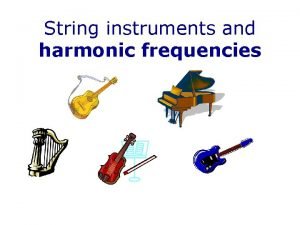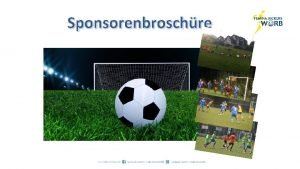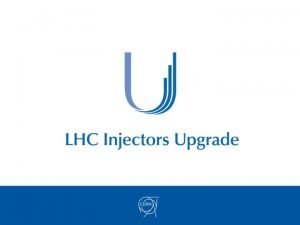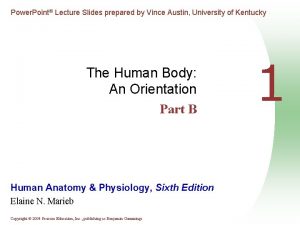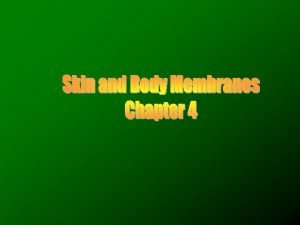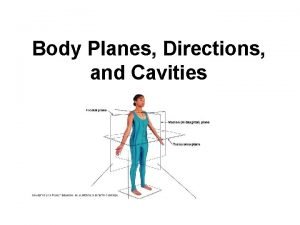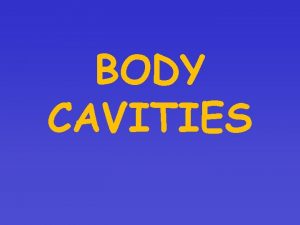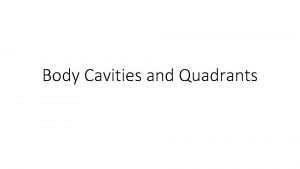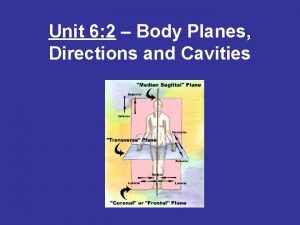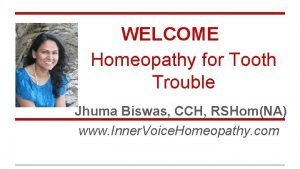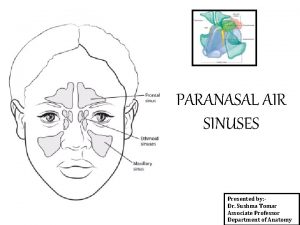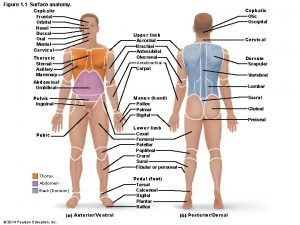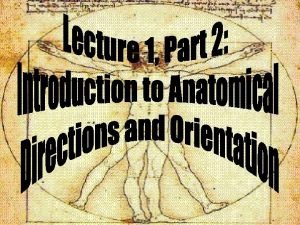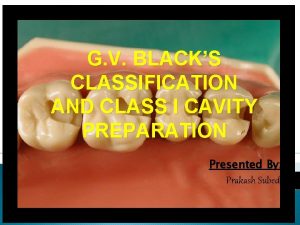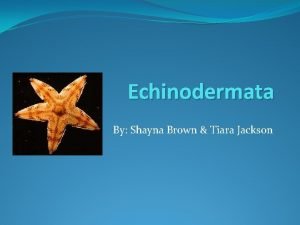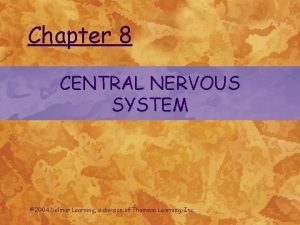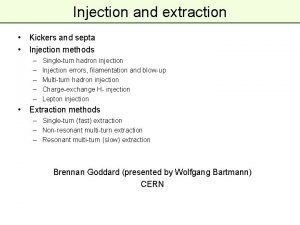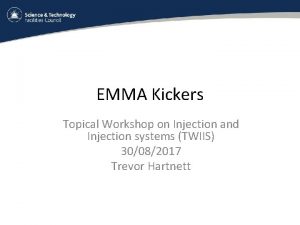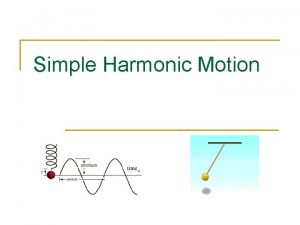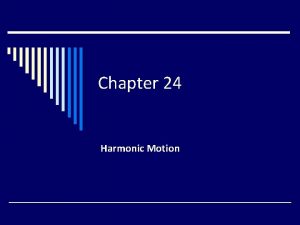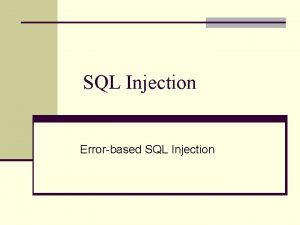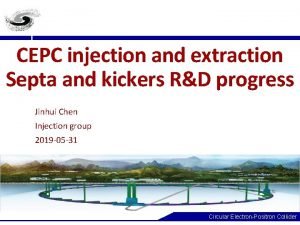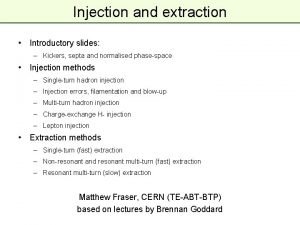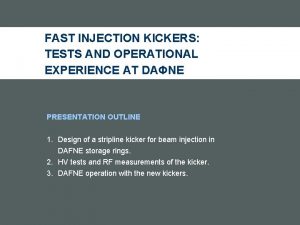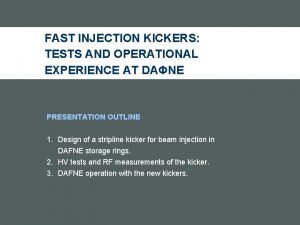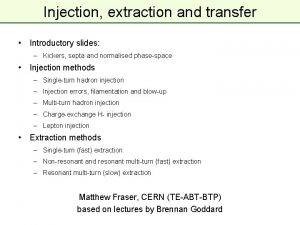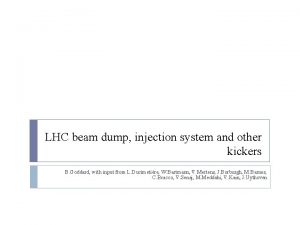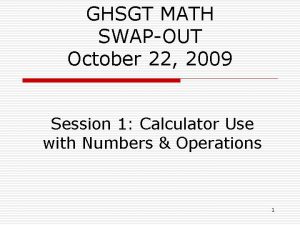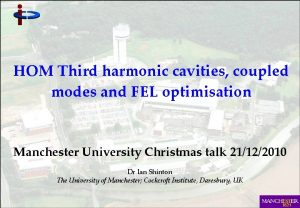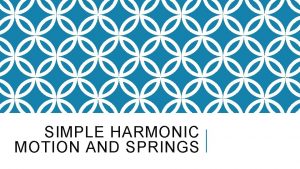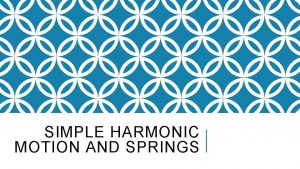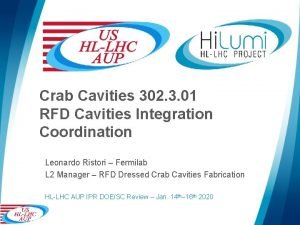Swapout Injection Kickers and Harmonic Cavities For The





















- Slides: 21

Swap-out Injection Kickers and Harmonic Cavities For The ALS-U Project Stefano De Santis, for the ALS-U Project Team October 28, 2016

Outline • Enabling technologies for the ALS-U Project – Injection/extraction kickers for on-axis injection (“swap-out”). – Higher harmonic RF cavities for bunch lengthening. • Moving from ideas to engineering – ALS test kicker: bench measurements – Harmonic cavities: multiparticle simulations, beam tests. LER 2016 WORKSHOP –SOLEIL, OCTOBER 26 -28, 2016 2

Fast Kicker and Harmonic RF System For The ALS Upgrade ALS-U • Bunch lengthening necessary to avoid IBS-driven emittance growth and improve lifetime. • On-axis injection allows to take advantage of beam dimensions by reducing the transverse dimensions of the machine: stronger focusing lattice, better undulator performance. LER 2016 WORKSHOP –SOLEIL, OCTOBER 26 -28, 2016 3

Kicker Activities • Design and prototyping of a test kicker on the ALS. – Same length (0. 5 m) and electrodes gap (6 mm) as the ALS-U: • Pulser and feedthrough integration, beam power deposition, beam coupling impedance, dielectric supports, rise time, residual fields. – CST modelling: impedance, power deposition, effects of dielectric supports and feedthroughs – Cold prototype testing and tuning: coaxial wire(s), TDR, magnetic probes. – Feedthroughs bench measurements: HF response. – Testing fast commissioning algorithms for beam-based first turn trajectory. • Ongoing pulser development. – Inductive adder. – Transmission line adder. LER 2016 WORKSHOP –SOLEIL, OCTOBER 26 -28, 2016 4

ALS Test Kicker Planned Installation: January 2017 ALS 35 mm 8 mm 9 mm 6 mm Cold test model ALS-U LER 2016 WORKSHOP –SOLEIL, OCTOBER 26 -28, 2016 5

Dielectric Supports and Feedthroughs Simulations Macor/Alumina supports - Presence of dielectric supports and feedthroughs substantially modifies beam coupling impedance. - Rather than trying to model the actual feedthrough, we considered a worst-case scenario BEAM POWER SPECTRUM X σ = 11 mm σ = 9 mm LER 2016 WORKSHOP –SOLEIL, OCTOBER 26 -28, 2016 6

Evaluating Beam Power Deposition • We simulate a single bunch passage (energy lost, port signals). • Derive analytically same figures for the ALS-U circulting beam. • Obtain power dissipated in the kicker by subtracting power outflowing from ports. • Identify where in the kicker the power is dissipated (Striplines, Beampipe, Dielectrics) by means of a variational technique. Model (SL-BP-Diel. ) Beam Lost Power (W) Port Power (W) Δpower/2 (W) Cu-SS-Disp. Diel. 68. 5 59. 3 4. 6 PEC-SS-Disp. Diel. 67. 3 60. 4 3. 5 Cu-PEC-Disp. Diel. 67. 7 60. 6 3. 6 No Feedthroughs 80. 9 78. 8 1. 1 LER 2016 WORKSHOP –SOLEIL, OCTOBER 26 -28, 2016 7

Feedthrough Bench Tests Ceramaseal feedthroughs transmission and reflection coefficients measured by network analyzer. Dissipation peaks not a concern. LER 2016 WORKSHOP –SOLEIL, OCTOBER 26 -28, 2016 8

Prototype Bench Tests • Transmission measurements in common and differential mode: feedthrough/stripline impedance matching. • TDR measurements on single electrode: stripline alignment, dielectric supports effect. • Coaxial wire method: longitudinal and pickup transfer impedance. • Coaxial wire method (2 wires): shunt impedance. LER 2016 WORKSHOP –SOLEIL, OCTOBER 26 -28, 2016 9

Transmission Measurements Response was as expected, except for sharp resonances appearing intermittently between 250 -300 MHz. - Reason: Bad contact between feedthrough outer sleeve and housing. - Impedance in parallel (Rs≈ 20 Ω, Q ≈ 70). - Confirmed RF fingers necessity COLD MODEL LER 2016 WORKSHOP –SOLEIL, OCTOBER 26 -28, 2016 10

TDR Measurements feedthrough BOTTOM TOP initial measurement - Vertical misalignment; one dielectric support broken. - Characteristic impedance sensitive to exact distance from beampipe: 2040 μm/Ω. - Realigned to 25 μm accuracy, dielectric supports redesigned. measurement after fixes LER 2016 WORKSHOP –SOLEIL, OCTOBER 26 -28, 2016 11

Coaxial Wire Measurements Challenges: Our standard 1/8” wire too large. Characteristic impedance extremely sensitive to wire displacement: 1 mm sag, usually negligible with larger components, is not allowable. Solutions: Setup turned on its side and fishlines through holes for the magnetic probes are used to level the wire. We procured 1/16” wires. LER 2016 WORKSHOP –SOLEIL, OCTOBER 26 -28, 2016 12

Coax. Wire Meas. – Transfer Impedance Measurement in line with expectations. First two response peaks affected by feedthrough resonance and degraded performance of our impedance matching tapers at low frequencies. LER 2016 WORKSHOP –SOLEIL, OCTOBER 26 -28, 2016 13

Pulser Development – Inductive Adder - 8 -stage 5. 5 k. V bipolar pulser fully assembled. - Output waveform tested on CST models: deflecting field rise time < 8. 5 ns, fall time 10 ns (5%-95%) already satisfy minimum requirements. - Readying for ALS installation. LER 2016 WORKSHOP –SOLEIL, OCTOBER 26 -28, 2016 14

Pulser Dev. – Transmission Line Adder - 4 stages assembled and undergoing tests - Output waveform shows some ringing; timing optimization. - Possible cause: flexible/rigid boards interface. LER 2016 WORKSHOP –SOLEIL, OCTOBER 26 -28, 2016 15

Harmonic RF System Activities • System parameters design. – 500 MHz main RF with 3 rd harmonic NC passive system is the main option. – Alternate: 100 MHz main RF with 5 th harmonic NC active system. – 500/3 rd advantages: • Lower peak charge density, we already have all components, facilitates hitting 3 -month commissioning target. • ALS experiments. – Using 2 cavities at higher power. LER 2016 WORKSHOP –SOLEIL, OCTOBER 26 -28, 2016 16

Harmonic RF System Parameters Loss/Turn Ib 260 ke. V 500 m. A depends on bunch length f. RF VRF nh Vh, opt tan(n hφh, opt ) Rs, opt Ph, opt 500 MHz 760 k. V 3 236 k. V 0. 139 1. 84 MΩ 15. 1 k. W 100 MHz 390 k. V 5 57 k. V 0. 193 330 kΩ 4. 9 k. W - Existing ALS harmonic cavities have Rs=1. 7 MΩ, but a single cavity cannot absorb 16 k. W. - Options: Redesign cavities (3 cavities with Rs≈610 kΩ, rated for 5 k. W) Use 2 existing cavities, moving away from ideal conditions. - Using two of the existing cavities total Rs=3. 4 MΩ, required power is 8. 2 k. W, i. e. 4. 1 k. W/cavity. - While cavities are designed to operate at powers in excess of 5 k. W, normal ALS setting is around 2. 5 k. W. - We tested the higher power setting on the ALS (temperature, HOM) LER 2016 WORKSHOP –SOLEIL, OCTOBER 26 -28, 2016 17

HHC Operation at ALS-U Power Level beam loss caused by temperature sensor 2 HHC Ops. 3 HHC Ops. - Cavities operated regularly at up to 4. 2 k. W with stable beam. - Tuner bellows temperature higher than normal, likely due to HOM coupling. - Increasing power to 4. 3 k. W caused beam loss due temperature reaching trip point. LER 2016 WORKSHOP –SOLEIL, OCTOBER 26 -28, 2016 18

HOM Tuning Range Measurements of HOM tuning range can help us identify responsible HOM and apply remedy. LER 2016 WORKSHOP –SOLEIL, OCTOBER 26 -28, 2016 19

Conclusions • On-axis injection kicker development well underway. – Critical test at the ALS upcoming: actual pulser, most of kicker characteristics will be tested with beam. – Some bench measurements more challenging than with larger sized components; we obtained useful information nonethless. • Harmonic RF system. – Taking advantage of HHC availability and opportunity on the ALS we are working towards a suitable solution for obtaining required bunch lengthening factors. – Use of tracking codes to estimate bunch lengthening will be expanded to include short-range wakefields. We have already obtained short-range wakefield data for a number of ALS-U components (resistive wall with NEG, tapers, RF cavities, synchrotron light ports). LER 2016 WORKSHOP –SOLEIL, OCTOBER 26 -28, 2016 20

Ackowledgments • • • M. Betz J. Byrd T. Luo C. Pappas S. Persichelli M. Placidi E. San Mateo C. Steier C. Sun C. Swenson M. Venturini W. Waldron LER 2016 WORKSHOP –SOLEIL, OCTOBER 26 -28, 2016 21
 Tension wave
Tension wave Femina kickers worb
Femina kickers worb Kickers fabrication
Kickers fabrication The anterior and posterior body cavities
The anterior and posterior body cavities Dorsal cavity
Dorsal cavity Chapter 7.2 body planes, directions, and cavities
Chapter 7.2 body planes, directions, and cavities Covers body surfaces
Covers body surfaces Labeling body planes directions and cavities
Labeling body planes directions and cavities Chapter 7.2 body planes, directions, and cavities
Chapter 7.2 body planes, directions, and cavities Vertebral cavity
Vertebral cavity Planes in body
Planes in body Vertebral cavity
Vertebral cavity Jhuma biswas homeopathy
Jhuma biswas homeopathy Air containing cavities in the bones around the nose
Air containing cavities in the bones around the nose 1
1 Body cavities labeled
Body cavities labeled Palm facing anterior
Palm facing anterior Arytenoid muscle function
Arytenoid muscle function Lingual groove
Lingual groove Body cavities
Body cavities The brain contains four lined cavities called
The brain contains four lined cavities called Health science 20
Health science 20
